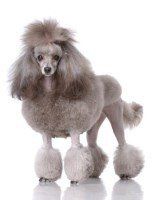Poodle Colors
Overview
There is so much to talk about regarding Poodle colors! Let's get started!
We will discuss:
- Poodle colors
- Parti-colors
- Phantom Poodles
- Mis-marks and more
- Color changes
Solid Colors
Let's first discuss solid colors. The majority of Poodles are solid and of those, the most common color is black. Here is the list of solid Poodle colors:
- Apricot
- Black
- Blue
- Brown
- Cafe Au lait
- Cream
- Gray
- Red
- Silver
- Silver beige
- White

Apricot -
This and red were two of the last colors recorded for this breed; so they are the newest and quite interesting. An apricot can produce a red. Some apricot Poodles are so light that they appear to be cream, however you will notice a red tint to the hair. A true apricot poodle will have some points or black spots on their skin. Liver points are acceptable but not preferred in the U.S. See More: Apricot Poodles
-167x140.dm.edit_4y1X9k-1920w.jpg)
Blue -
This is a diluted (faded) black. All blue Poodles are born black and then "clear" (lighten) as the pup grows.This often happens within the first year but this change can take place as late as 2 years in some cases. For this reason, many blue Poodles are registered as black. The outer coat of a blue poodle is usually as dark as that of a black, but hairs at the root is a mix of colors. The amount of each color depends on the age of the dog. In middle-aged dogs, medium brown predominates. True blue Poodles will have black points and dark brown eyes.
-108x170.dm.edit_kWc2jr-1920w.jpg)
Brown -
A brown Poodle is a deep, dark color and in no way can be confused with Cafe Au lait which is much lighter. Pure brown Poodles must have liver points and dark amber eyes. Brown is created by the bb gene, as opposed to the BB gene of black Poodles, and therefore will have no black pigment anywhere on the body, including the eyes and nose.

Cafe Au lait -
This is a shiny light tan color and some confused this with silver beige. It is not uncommon for the pup to be born brown and 'clear' to this color . A Cafe Au lait should have liver points and dark amber eyes.

Black -
A true black Poodle is a deep ink black. The dog's coat will have zero blue or silver tinting and not have any white or silver guard hairs. The face when shaved will be deep black, as well. A true black will not "clear" or "fade". Blacks will have black points and dark brown eyes. See More: Black Poodles.

Silver Beige -
This is a diluted brown, therefore a true silver beige Poodle is born brown. By 6 weeks, silver beige will appear on the face and paws with a full coat change by the age of 2 years. The dog will have liver points and dark amber eyes.
-142x189.dm.edit_dlSt0O-1920w.jpg)
Red -
This only became an official color in 1980 and now many breeders in Canada have come together to form the Apricot Red Poodle Club. A true red will have black points. Liver points are acceptable but not preferred in the U.S. Read about the fascinating history of reds here: Red Poodles.

Silver -
A true silver Poodle is born black and "clears" by the age of 2. However, you will know a true silver by the age of 6 weeks, when the face and paws "clear" and the rest of the coat will follow in suit over the next year or two. Silvers will have black points and dark brown eyes. This color is a diluted gray, caused by the silver allele V gene.
-126x189.dm.edit_EgctFG-1920w.jpg)
White -
Most white Poodles are a pure, snow white. However, some breeders will dub a white tinted with apricot or beige as being white. A bit of black spotting is acceptable on a white, however there should never be any ticking in the white. The ticking gene is a totally separate gene that makes the coat appear dirty.

Gray -
While a Poodle can be born gray and stay gray, it is also not uncommon for a black Poodle to turn gray at the age of 4-5 years old.

Cream -
These Poodles will have black points; you'll know that a Poodle is cream and not Silver Beige or Cafe au Lait if his nose is black. It is the Cch gene which causes an otherwise brown Poodle to be cream.
Color Changes
When a Poodle puppy is a solid, one must understand that many variables can affect what will become the adult coat. When a pup keeps the same color coat, this is known as "holding". However, many Poodles 'clear'.
To clear means when the coat fades or lightens to another color. A lightening of the coat does not necessarily occur evenly all over the coat, rather Poodle color will often hold more on the dog's ears and the thicker guard hairs.
- Cafe Au lait Poodles are born dark brown and change to cafe around the age of 2 yrs
- Blue Poodles are born black and change over by the age of 2 years
- Sliver Poodles are born black and change over by the age of 2 years
- Apricots are often born a dark shade that lightens by the age of 2 years
Many owners can become confused as their Poodle takes on a completely different color as they grow.
For example, a blue Poodle puppy could be misinterpreted as black, although a reputable breeder should be able to know the difference. If that puppy has parents with parti in the bloodline, as the coat clears during the first 2 years, other colors may appear and the once black looking puppy who was actually a blue parti becomes a parti with a wide array of possible colors.
Fixing a Dull or Yellowing Coat
It is common for a Poodle's coat to dull, become brassy or yellow as the dog matures. Sunlight, air pollution and constant bombardment of minuscule debris are at work here, in addition to the natural aging process cycling out a duller color than a Poodle once had.
At all times, each hair strand is in 1 of the 3 phases: Growth, rest or release. Therefore, it is a gradual process... some hairs grow in while others are resting and still others are releasing (shedding off).
Owners may not notice a difference in the richness, depth and shine of the coat until the process has been going on for a while and enough hairs have grown in faded or dulled to make a drastic difference.
The key to fixing and maintaining a beautiful color on a Poodle is to use a color enhancing shampoo. There are some great ones manufactured specifically for canines. In addition, while in general one does not want to use a human product on a puppy or dog, as long as the PH balance is correct, it most certainly can be used with excellent results.
When a Poodle Turns Gray
Poodles have a gene that is called 'Progressive Graying', called the G locus. When a black, blue, or brown dog has the mutation in this gene, they gradually fade in color as they grow.
Not all black, blue, or brown poodles have the mutation, but some do. Since it is a dominant mutation, if one of the parents was Progressively Graying, then there is 50% chance that the pups have the mutation as well. You will begin to see the change in color starting at a 2-3 months of age and it is usually complete by the time the dog is mature. In some dogs there may be small changes throughout the life of the dog.
Skin Color
Skin color can change as well. The most common reason for a Poodle to have a change of color on the skin is exposure to sunlight and this most commonly happens on the belly. It is not uncommon for a pink belly to have darker spots appear.
An owner should be concerned if those darker spots are raised above the skin and should have the dog's veterinarian take a look at any raised, dark areas.
See Also: Parti Colored Poodles - This is such an interesting color for this breed and some of the combinations are quite beautiful.
Phantom Poodles - These may sound mysterious, but they are a real and eye-catching variety of this beloved breed. See what makes a Poodle 'phantom', and how this differs from other coat patterns.
